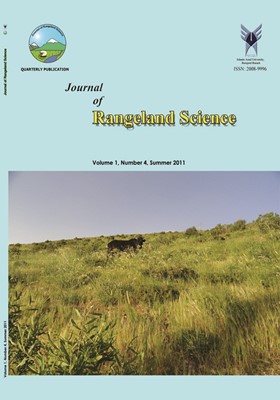Quantifying the Rate of Environmental Factors Effect on Astragalus verus and Agropyron trichophorum Using Decision Support System and Multivariate Analysis of PCA
محورهای موضوعی : Relationship between Animal and RangelandMohsen Aliakbari 1 , Mohammadreza Vahabi 2 , Amir Saadatfar 3
1 - Range management, IUT.
2 - Faculty of Natural Resources, Isfehan University of Technology.
3 - Range management, Gorgan Agricultural and Resources University.
کلید واژه: AHP, Decision Support Systems (DSS), Multivariate analysis, Astragalus verus, Agropyron trichophorum,
چکیده مقاله :
Vegetation cover over time and space is the result of interactions betweenvegetation cover and environmental factors. Changes occurred in range covers are caused bymatrix dominance, one of the most important environmental factors. Decision support system(DSS) could be used for determining the rate and importance of each factor. Actually, inmethods based on DSS, relations between input and output factors are identified. Up to now,various methods have been used in analyzing multivariate decision that includes binarycomparison method that has been used in this study. This method has become one of the mostcommonly used methods of multivariate decision making and has been used for resolvingunstructured issues in various human areas such as agriculture and natural sciences. In thisstudy, nine sites were selected in west of Isfahan, Iran, then different vegetation cover andenvironmental factors were examined in each of these sites. By analyzing main components,effective factors and impact of range were identified, finally using analytical hierarchicalpattern (AHP) model, the quantity of effective factors on Yellow Astragalus and grass siteswas determined. The rate of limestone of soil and slope factor in Yellow Astragalus were 14.4and 14.2%, respectively, which have the greatest effect and with regard to grass transmittal,Soil limestone and soil acidity influenced 20 and 13.2% of variation, respectively.
Asgharpour, M. G. 2005. Decision support
system, Tehran University, Third edition,
399 pages (In Persian).
Beta, J., Suparn, P., Shahrama, J.R. 2009.
Land suitability evaluation for mulberry
plantation. A remote sensing and GIS
based application, 17th World Congress
of Soil Science, Thailand, Paper No. 579
(In Persian).
Garcia-Aguirre, M. C, Oritz, M.A,
Zamorano, J.J. and Reyes, Y. 2008.
Vegetation and landform relationship at
Ajuco volcano Mexico, using a
geographical information system (GIS).
Forest Ecology and Management, 23: 1-
12.
Ghodsi Pour, H. 2002. Analytical
hierarchical pattern AHP. Amirkabir
University Press, Iran Pp, 110. (In
Persian).
Grims, P. H. Hunter, J. G. 1990.
Comparative plant ecology: a functional
approach to common British special
university of Sheffield, UK.
Jafari, M., M.E., Zare Chahoki, H.
Azarnivand, N. Baghestani and G.
Zahedi. 2003. Relationship between
pasture vegetation with physical and
chemical properties of soil at Pishkuh
Yazd Rangeland. Iranian Jour. Natural
Sci., 55: (In Persian).
Jarvis, C.H., Stuart, N. and Hims, M. 2002.
Towards a British framework for the
enhanced availability and value of agrometeorological data. Applied Geography
22: 157–174.
Malczewski, J. 2004. GIS-based land-use
suitability analysis: a critical overview.
Jour. Progress in Planning, 62: 3-65.
Malczewski, j. 2008, Geographic
information system and MCDM,
translated, Parhizkar & gilandeh.
Mesdaghi, M. 2002. Vegetation
Description and Analysis. Mashhad
University Press. Pp, 286. (In Persian).
Parhizgar, M. and D. Gilavand, 2008.
Geographic information systems and
multiple criteria decision analysis. Nashr
Press. Pp, 250. (In Persian).


